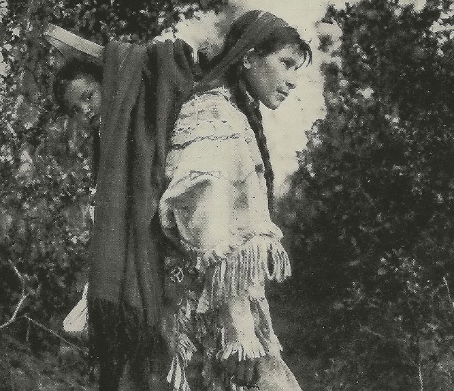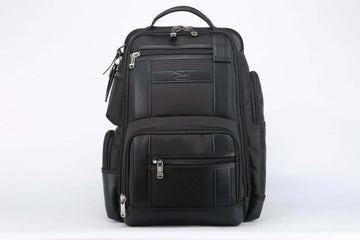A brief history on backpacks
Ah, the backpack. It’s a staple of back-to-school vibes and the busy hiker aesthetic. But where did these convenient bags get their start? How long have backpacks been around?
It might surprise you to learn that they’ve been here since the very beginning of humanity. Here’s what you need to know about backpacks and how the vegan leather version became the choice of the modern world.
A History of Backpacks
If your definition of “backpack” is just “a container with straps held over the shoulders,” then the oldest backpack in the world would be the frame found alongside Otzi, “The Iceman.” Otzi was found in the Alps in the ‘90s, and is estimated to be from about 3,300 BC.
What remains of his back is a U-shaped piece of hazel with two wooden boards we assume were attached. Experts theorize that the Iceman used a hide sack or a piece of netting to keep his belongings in place – clearly, he was the height of fashion.
 Otzi's backpack frame is in three pieces. Image via the South Tyrol Museum of Archaeology.
Otzi's backpack frame is in three pieces. Image via the South Tyrol Museum of Archaeology.
Native Americans from various tribes have also used framed devices carried on the back for centuries, although we’re not sure exactly when they started using them. Fun fact – some tribes even used these frames to carry their children on their backs!
 A Chippewa woman holds her child on her back with an...interesting...frame. Via Flickr.
A Chippewa woman holds her child on her back with an...interesting...frame. Via Flickr.
The more modern version of the backpack has been around since the early 1600s, when Germans referred to them as knapsacks, from the word “knapp,” which means food, or rucksacks, from the word “ruck(e)” meaning “back.”
They weren’t commonly used, though – more often than not, people would carry satchels made to be worn cross-body for work or school. The first common use of the rucksack was during the first World War, as a military provisions pack.
 A German World War I rucksack. Via Wikimedia Commons.
A German World War I rucksack. Via Wikimedia Commons.
These were simple, frameless bags made of natural materials and animal hides, mostly used by workers to transport goods, and by sportsmen to carry equipment. The first truly modern-style frameless backpack, with two straps and a zippered pouch, came onto the scene in 1938, when Gerry Outdoors debuted a bag designed recreational sports.
 One of the original Gerry Outdoors frameless zippered backpacks. Via Gerry Outdoors.
One of the original Gerry Outdoors frameless zippered backpacks. Via Gerry Outdoors.
Backpacks for school use are a fairly recent innovation. They first arrived on the scene a little more than 40 years ago, when Gerry Outdoors and JanSport introduced light “daypacks,” designed with students in mind. These packs were made of nylon or canvas, and soon became not just a schoolyard necessity, but a fashion statement.
Modern backpacks tend to be small, sleek, and designed with technology in mind given the trend of textbooks and other frequently carried materials going digital. They’ve also become a replacement for regular handbags in recent years, as people find it more and more convenient to carry their belongings hands-free and out of the way.
The most recent innovation is vegan leather backpacks, which got popular with the dawn of vegan leathers in the mid-20th century. This innovative material meant that you could have that leather look without the guilt accompanying it. A win on all fronts!
Doshi’s Vegan Leather Backpacks
Doshi’s taken the extra step to design backpacks that are both good for your closet and good for your heart. Our vegan leather backpacks are classically designed and ethically made so that you can have your style without having to hurt animals in the process.
For School Life
If you’re gearing up to go back to school in the fall, Doshi has you covered.
- Our Lux Punk Backpack is spacious and studded for extra style points. Its smooth zippered pouch includes a built-in sleeve for your iPad or e-reader so you can keep all of your supplies on the on-hand and safe. Its padded straps are designed for comfort, even when jogging from class to class.
- The Doshi Lux Ribbed Backpack is simple and clean while staying a solid statement piece. The high-quality vegan leather pouches have plenty of room for your books, tech, and daily essentials, and with solid construction and soft accent straps, you can rest assured that your things are staying exactly where you put them.
For Sport Life
If you’re more of the adventuring type, Doshi’s got a couple of great options for you, too.
- Our Pro Sport Travel Backpack is perfect for an urban adventurer. This heavy-duty pack is made with a strong nylon shell for better weather proofing and vegan leather accessories for style. Its padded and ventilated back makes it comfortable for long hikes, while its stand-alone laptop sleeve, ID tag holder, and hidden pocket make it perfect for convenient travel.
- Need even more room on your adventures? Our Pro Sport+ Travel Backpack is stylish luggage with space for everything. It’s got multiple pockets inside and out to keep your supplies organized, and a laptop sleeve that fits up to a 15.6-inch screen. This bag is as multipurpose as it is animal friendly.
For Daily Life
Looking for something smaller that can match your everyday style? Doshi has options for you to try.
- Our Debut Slim Backpack is a colorful pop of vegan leather as part of our Slim Vegan Rockstar line. It’s made from exclusive materials (available from a single factory!) and features two zippered pockets plus a zippered back valuables pocket for easy organization.
- Leather looks not quite your style? Try our Debut Paper Backpack! It’s made from Kraft Paper and Tyvek lining for a sleek, rustic, and environmentally friendly product. The paper is tough and water resistant, as well as being up to 90% biodegradable. With an adorable fold-over design, this bag is a sustainable fashion dream.
Sources:
“A Brief History of the Modern Backpack” from Time
”Otzi the Iceman” from Penn Museum
“The Iceman’s equipment” from the South Tyrol Museum of Archaeology













